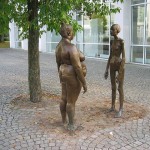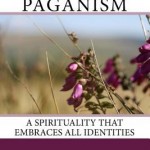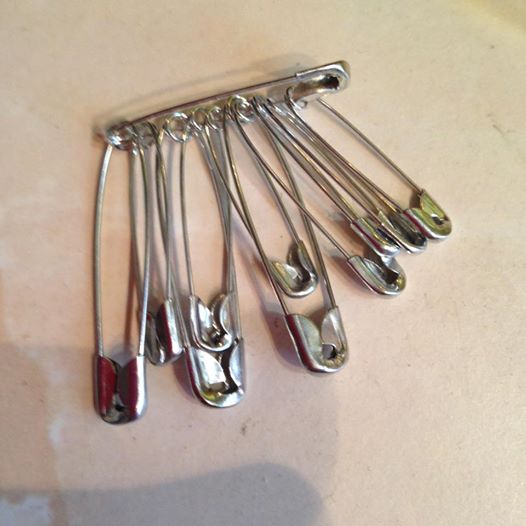Over at AndersonFaery.org, Helix has written an excellent and fascinating article about the old way of being a witch and the new way of being a witch. I think it is a useful model to explain why there is conflict over many aspects of the Craft – how to teach it, who can benefit from it, and how witches should engage with the world. The “old way” and the “new way” that Helix describes are two poles at either end of a spectrum. I would say that very few people are purely “new way” or purely “old way”. For example, I started my Craft journey with a lot of the assumptions of the “new way”, but I am a member of a tradition that is in many respects “old way” and so my practice is a synthesis of the two. Nor do I think it is necessarily the case, as Helix says, that you must be either “old way” or “new way”. She writes:
What I earnestly ask you not to do is to hybridize these two ways without deep reflection. The truth is, the Old Way and the New Way are already all mixed up in modern witchcraft traditions, and the fact that they reflect two separate and largely incompatible ways of being has not been recognized. The results have often been destructive.
The two ways are already all mixed up in modern witchcraft traditions. Doesn’t that mean that a synthesis already exists, then? Which means that we don’t need to reinvent the wheel, but can follow the Middle Way. I suspect that a lot of what I am about to say will make more sense if you read Helix’s article first, but it might work as a standalone piece. It’s up to you.
![Coast path near Bindon Cliffs The path (Axmouth Footpath 2) spends most of its time along this coast in woodland which has grown up on the jumble of broken land. A mysterious touch is added here by the luxuriant growth of harts-tongue fern and ivy below hazel trees. Creative Commons Licence [Some Rights Reserved] © Copyright Derek Harper and licensed for reuse under this Creative Commons Licence.](https://wp-media.patheos.com/blogs/sites/311/2015/11/coast-path-bindon-cliffs-300x225.jpg)
The path (Axmouth Footpath 2) spends most of its time along this coast in woodland which has grown up on the jumble of broken land. A mysterious touch is added here by the luxuriant growth of harts-tongue fern and ivy below hazel trees.
© Copyright Derek Harper and
licensed for reuse under this Creative Commons Licence.
Very broadly, Helix characterises the Old Way as embedded in community and locality, and being about relationships with the land and one’s local community. It takes the view that politics (of the pressure-group and parliamentary kind) is ephemeral and transitory, and that everything is cyclical, and that we have seen all this before. It does not teach in large groups for money, because teaching is about relationship. It also takes the view that not everyone is called to be a witch, or has the necessary skills, aptitudes, and inclinations.
The New Way, on the other hand, while it acknowledges the cyclical nature of reality, says that we are at a crisis point and need to be politically engaged in order to transform the world. To this end, we need to train as many people as possible in the techniques of witchcraft, in order to bring about that transformation. It regards teaching in large groups as necessary in order to spread the message, and money as a means of energy exchange.
Helix has a great list of the differences between the two, which is well worth a read. I found myself agreeing with some of both approaches, though, which is why I think there is value in both ways, and that a synthesis or middle way is possible. In fact, Helix says as much:
“The Old Way” and “The New Way” are categories that I have created to help readers think about differences in approaches to the Craft. They are not meant to be definitive or 100% historically-based, and it is normal for an individual witch to have elements of both.
A “middle way”
The most famous usage of the term “Middle Way” is of course the Middle Way in Buddhism. The story goes that the Buddha first tried ascetic practices to reach enlightenment, and ended up very emaciated as a result. Then he tried hedonism as a way to enlightenment, and found that didn’t work either. So then he invented the Middle Way – moderation in all things. The middle way between the two positions articulated by Helix will be different from Middle Way Buddhism, of course, because it is not a middle way between asceticism and hedonism, but a middle way between two different poles, which we might characterise as local and global, or maybe even religion and spirituality, or embedded and networked.
Because the “old way” and the “new way” are complex and cohesive worldviews, it is difficult to come up with a shorthand term to describe them. I will try to articulate my suggested middle way by using the same headings as Helix, for ease of comparison.
Time and Justice
In the “middle way”, witches are aware that time is cyclical, but also that “the arc of the moral universe is long, but it bends towards justice” (Martin Luther King, paraphrasing Theodore Parker). We know that there is an ecological crisis, but feel that there is still hope of change. We know that capitalism sucks, but we also feel that there was a time in the past when it didn’t exist, and there will be a time in the future when it will become obsolete. Rather than our focus being entirely local or entirely global, we are aware of the interconnectedness of the global and the local, and that the one is a reflection of the other. “As above, so below.” The apocalypse is not at hand, but it isn’t business-as-usual either. So, in the manner of Odin at the Well of Mimir, we need one eye on the outer world, and one on the inner world. The role of the witch is to straddle the hedge, the liminal place, between inner and outer, light and dark, global and local, community and solitude.
Self, Community, and Training
In the “old way”, training appears to have been largely one-on-one. Trad Craft groups seem to envisage a witch training only one successor. In the “new way”, teaching is mostly in large groups, and can be done by distance learning. Surely the middle way (which, thankfully, already exists) is the coven? In a coven, you get the sense of community and individuality, and the intimacy of a small group. You get the individual development by having your corners rubbed off by the group, and avoid the lack of feedback that you would get in solitary practice and large impersonal classroom settings. You might also be aware of a network of other covens who have similar intimate training settings. It is not your duty to train everyone who asks you for training; but it probably is your duty to train those who have an aptitude, who will benefit from your training, and who will put in the commitment to the work. Luckily, when you get students who fulfil those criteria, this duty is actually a pleasure, and something that the teacher will also benefit from (which is why we never charge for coven training).
Secrecy and Silence
The middle way distinguishes between secrecy, confidentiality, privacy, and the mysteries.
Secrecy is necessary to protect the mysteries from the profane, and to protect the inexperienced from confronting the powerful nature of the mysteries without proper preparation. It should never be used to be excluding, or to assert power and privilege over others. Confidentiality is important for several reasons: because the Craft is so misunderstood by outsiders that we need to protect ourselves; because if someone confides something private to you, it is just that, private.
As KNicoll commented on a book review:
If you invited someone who worked as a food columnist over for family dinner, do you expect to hear about a article afterwards that reveals the menu, criticises what people were wearing, reveals intimate details about people’s lives from the before-dinner discussions, and includes the addresses of some of the guests? Of course not!
Not only are the details of someone’s personal life private, but also certain aspects of our rituals, which are unique and special to a particular covens, and only get shared with people we love and trust.
The mysteries are so experiential and often non-verbal that it’s almost impossible to explain them to someone else; you just have to experience them. The only possible response to the mysteries is silence. They are that which (literally) cannot be spoken, cannot be communicated, only experienced directly or not at all. And the secrecy that is hedged about our rituals is to prevent the unwary and inexperienced from stumbling across the mysteries and being hurt by the encounter.
Money
In the “middle way”, you do not pay for coven training, but you might pay for classes and workshops where there is no ongoing relationship. The middle way distinguishes between the coven setting and other contexts. The coven setting is a tribal setting, where no-one counts the cost of what they do, everyone just does their best and knows that “what goes around comes around”. The wider community is more like a village, where we barter our skills for other people’s skills. And a large event or conference is like a city, where there is little or no ongoing relationship, so we trade our skills and knowledge for money. The middle way witch is quite happy to write a book, but will emphasise that book-learning must be complemented by coven learning, where you can have the experiential learning that is necessary for a full understanding of the Craft. The middle way witch tries to synthesise left-brain and right-brain approaches. “Middle way” witches likes to keep their feet on the ground by having a regular job, but also engage with wider issues, and might have a blog or write books, where they explain some of the techniques of witchcraft, and provide a means of entry to the Pagan worldview, ethos, and values.
Purpose
The purpose of witchcraft in the middle way is both individual development and community cohesion, and a recognition that you can’t have one without the other. The middle way witch recognises that the state of the world is not ideal, but also doesn’t think that the apocalypse is at hand, and hopes that the crisis can be averted by peaceful means. Middle way witches recognise that we are in relationship with all beings, and therefore wish to avoid violent revolution. If this all sounds hopelessly bourgeois, I am sorry, but transformation can be peaceful and yet still powerful. Look at the non-violent overthrow of many totalitarian systems, and the massive sea-change in attitudes towards homosexuality that has happened in a generation – in my lifetime, in fact.
Where next?
As Helix rightly points out, the “old way” and the “new way” are primarily tools for thought – but they are also cohesive models which people do largely follow. I have noticed people who lean towards one or other of these poles regarding each other with complete mutual bafflement. However, I do think there is value and wisdom in both approaches, which is why I have tried to provide a synthesis, or third way, or middle way, between the two. We can’t afford not to engage with the current ecological crisis; but on the other hand, we don’t want to lose the ethos and values of the “old way”, which are part of the solution to the problems we face. Therefore, I would encourage people to read Helix’s article, look at the suggestions for a middle way that I have offered, and ponder where your own practice and values sit on the spectrum between the poles.
As the Queen of Elfland said to Thomas the Rhymer:
‘O see ye not yon narrow road,
So thick beset wi’ thorns and briers?
That is the Path of Righteousness,
Though after it but few inquires. ‘And see ye not yon braid, braid road,
That lies across the lily leven?
That is the Path of Wickedness,
Though some call it the Road to Heaven. ‘And see ye not yon bonny road
That winds about the fernie brae?
That is the Road to fair Elfland,
Where thou and I this night maun gae.
There is always a middle way, though it is increasingly becoming a “road less travelled”.
















